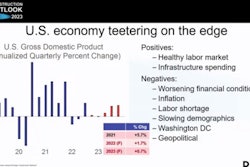
As time passes, contractors who own their business must navigate a fine line between blue collar and white collar tasks. They need to know how to build that detail. They need to understand logistics. They need to be able to get their bags on and perform an array of jobs. They need to understand financing, cash flow and payroll. However, no one can be the master of all subjects. The most successful contractors often have the best teams of professionals — both blue and white collar — surrounding them.
Many of the contractors I know struggle with three problems. They haven’t defined what retirement looks like and, are unsure how to get there. Their tax bills seem high and it is difficult to keep good people.
Planning for Retirement
Let’s start our conversation with retirement. Do you know what your retirement looks like? Are you just going to sit on your couch? Are you going to do nonprofit work? Are you going fishing?
Retirement is very similar to bidding a job. You need to make estimates, give yourself some buffers and identify margins. Next, if you’re hoping to sell your company, a contracting/construction business is notoriously difficult to sell. Private equity likely isn’t an option (bonding requirements and the cyclical nature of the business create problems that limits PE’s interest).
Third party buyers are harder to come by then a California Coastal Commission approval. No surprisingly, most contractors are aware of the above. The logic is fairly straight forward, no one else is quite in the same position as the owner to benefit from all the relationships ownership has built. Who knows your clients, employees and vendors as well as you? Who is in a position to benefit from the relationships and trust you’ve built over the years? Your employees are a great option; except, often, they don’t have the money. You can help them overcome that obstacle and benefit alongside them.
In looking at U.S. Bureau of Labor Statistics data for many industries, construction has a high turnover rate. How do you stem that tide? Give employees an opportunity in your business. If you are considering an exit in the next five to 10 yrs., your employees will stay if they have something to gain and, importantly, something to lose if they leave.
A job and bid starts with a set of plans (or defined specs); an exit requires a set of plans/docs. You shouldn’t take on a buyer or bid without a set of plans. Why? A good plan addresses taxes before a buyer and bid. The Internal Revenue Service (IRS) frowns upon people avoiding taxes. The IRS, however, does not frown on people structuring the manner in which they pay tax. Additionally, the government encourages responsible corporate governance and provides benefits when business owners choose to elevate their rank and file.
Employee Stock Ownership Plan (ESOP)
The best exit planning tools bring together people, planning, and funding. An example of that tool is an ESOP (Employee Stock Ownership Plan). A tool is only as good as the job for which it is designed. ESOPs aren’t the only tools available. Installment sale trusts, phantom stock, stock appreciation rights (SARs), stock options, etc. should also be considered. Each tool has different applications based on your needs.
Our first recommendation, determine what you want from your exit. An advisor shouldn’t have your solution on Day 1. While an ESOP is often a good solution for contractors, a professional should start with an intent to draft plans, not sell a product. An advisor should get to know you, your goals and your company.
Let’s review the process of creating an ESOP while understanding that this process looks similar to other tools that could be used. This can serve as a good roadmap if you’re looking to make a Gantt chart or similar.
First, assess if all the owners are on board. You don’t want to go through all the other steps just to find out a minority owner is going to create headaches. Obviously, this is easier for some businesses than others. All owners need to be, at a minimum, open to discussion.
Second, create a feasibility study. We need to confirm everything laid out and prepared for the process. Finances are going to support the structure to come. You could try and do this in house we would recommend finding an advisory firm that specializes in buyout and merger and acquisition strategies. This firm should be able to compare and contrast different types of plans and identify the best fit. We want advisors, not salespeople. Analysis should identify sufficient cash flow to support the ESOP’s stated purposes. Finally, you’ll need to confirm the company’s payroll is adequate to make ESOP contributions deductible for participants and repurchase obligations can be satisfied.
Third, you’ll need to value the company’s stock. The buyer and seller need to agree to a price. You need to appraise the company before implementing a plan. Importantly, the ESOP trustee should be the party to select and hire the appraiser. This eliminates conflicts of interest arguments by any regulators. An appraiser will review cash flow, profits, assets, goodwill, market conditions, values of comparative companies, etc.
Fourth, draft a plan. You’ve identified what you want from the process and confirmed you can afford the process. The advisor helping you with the assessment should be able to refer you to an attorney. You’ll need to hire an ESOP attorney to draft the plan. Attorney’s have E&O insurance in the event they make a mistake on your plan documents. This is not the place you want to go cheap.
Fifth, fund your plan. Funding can be done through a traditional bank, private parties, through ongoing company contributions, and/or through wage benefit concessions by employees. Be sure that the funding matches with the long term goals of ownership.
Sixth, you must maintain the plan. ESOPs requires oversight, compliance, and reporting to maintain preferential tax treatment. Plan to communicate with employees becoming owners, this represents a new, uncharted chapter in their lives.
Finally, let’s review some simple guidelines for those considering these structures.
These minimums represent the starting point. You company has been operating for more than three years, has more than 15 employees, is profitable, EBITDA of $1.5 million and a capable management team can succeed the owner. As the business owner, you realize that what you receive from the sale of your business is more important than the starting sales price. Taxes take their bite. You want to maximize the value you keep. Additionally, you are looking for a gradual sale/transference of your business, liquidity (or the ability to take some chips off the table), and a desire to reward your key people.
Reasons to Remain Cautious
If you see the following, this may not be a good tool: your people don’t have an interest in the company’s success, your company culture is toxic, you lack a strong management team, ownership isn’t open to helping their key people to an ownership position or if the business is struggling financially.
Be honest about the last paragraph. You don’t want to exacerbate the above problems. It can cause more problems than it solves. These structures are complex, require expertise, time, compliance and management.
The upside is that the structure offers flexibility and some amazing tax benefits for the person selling and during the operation of the business.
Selling a construction business is not for the faint of heart. Happily, your buyer may be sitting across the hall from you. Take some time to chat with a good advisor. We want to understand your goals before making recommendations. While this may take some time, it will likely result in better long term value for you.
Disclosure: Standing Oak Advisors and Centaurus Financial, Inc do not offer tax or legal advice.


















